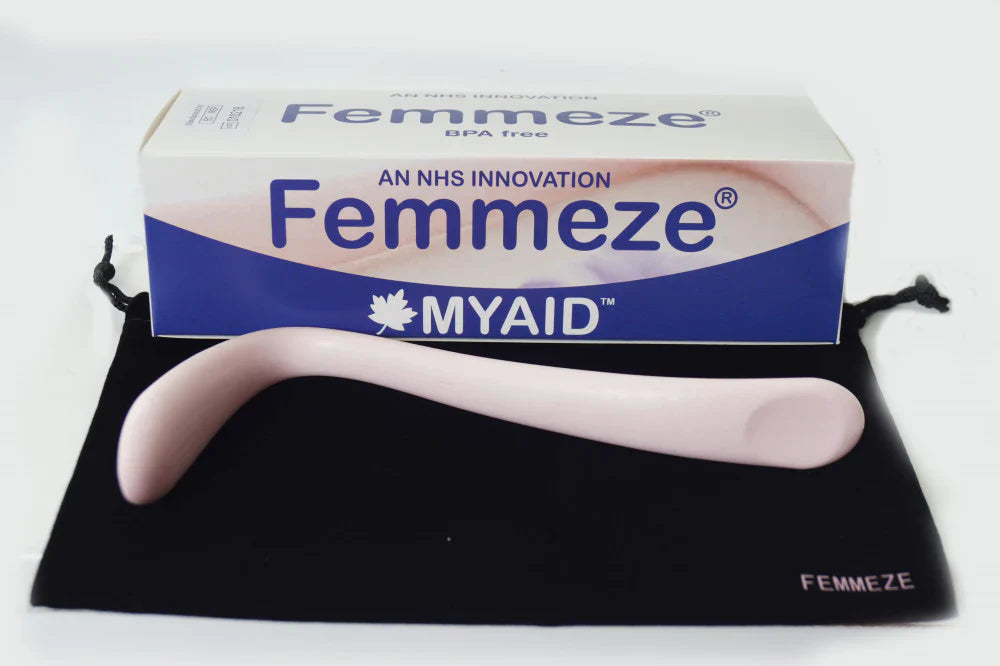Introduction
Millions of women worldwide suffer from conditions related to pelvic floor dysfunction, and one lesser-known solution to alleviate discomfort is vaginal splinting. For those dealing with rectocele—a condition where the rectum protrudes into the vaginal wall—splinting can offer an effective way to manage symptoms and improve quality of life.
However, many women are unaware of this technique, and even fewer are familiar with tools like the Femmeze device, which is specifically designed to aid in splinting. Misunderstandings around these options can lead to ineffective management, unnecessary surgeries, or prolonged suffering.In this article, we will explore what vaginal splinting is, why it is crucial for managing rectocele, and how the innovative Femmeze device can provide a safe, effective solution for women suffering from pelvic organ prolapse.
Part 1: Understanding Vaginal Splinting and Rectocele
1. What is Vaginal Splinting?
Vaginal splinting is a technique used primarily by women experiencing rectocele or other forms of pelvic organ prolapse to facilitate bowel movements. The process involves manually applying pressure to the vaginal wall, which in turn helps realign the rectum, making it easier to pass stool without straining.
- This method is especially helpful for women suffering from pelvic floor dysfunction, where the muscles are too weak to support the rectum adequately.
- Splinting can be done manually using fingers or by utilizing medical devices designed for this purpose, like the Femmeze tool.
Key Benefits of Vaginal Splinting:
- Reduces straining during bowel movements
- Prevents worsening of rectocele or other prolapses
- Provides an immediate, non-surgical solution
2. Understanding Rectocele: Causes and Symptoms
A rectocele occurs when the tissue between the rectum and the vagina weakens, causing the rectum to bulge into the vaginal wall. This condition can result in a range of uncomfortable and disruptive symptoms:
Common Causes of Rectocele:
- Childbirth trauma: Vaginal deliveries, particularly those involving large babies or forceps, can damage the pelvic floor muscles.
- Chronic constipation: Straining during bowel movements over time can weaken the support structure of the rectum and vagina.
- Heavy lifting: Repeated lifting of heavy objects puts strain on the pelvic muscles, exacerbating conditions like rectocele.
Symptoms of Rectocele:
- Difficulty with bowel movements, often requiring manual pressure to assist
- A sensation of bulging or pressure in the vagina
- Pelvic discomfort, particularly after standing for long periods
- Incomplete bowel evacuation, leading to constipation or the need for frequent trips to the bathroom
Rectocele is often associated with other forms of pelvic organ prolapse, such as cystocele (bladder prolapse) or uterine prolapse, making it crucial to address the condition early to prevent worsening.
3. How Vaginal Splinting Works for Rectocele
The process of vaginal splinting involves the strategic application of pressure to the vaginal wall to realign the rectum during bowel movements. Here’s a simple breakdown of how it works:
- Insert a clean finger into the vagina, applying gentle pressure to the vaginal wall toward the rectum.
- This manual pressure helps push the rectum back into place, facilitating easier stool passage.
- The technique can be used in various degrees of rectocele, depending on the severity of the prolapse.
When to Use Vaginal Splinting:
- If you are experiencing difficulty passing stool despite the urge to do so
- When traditional remedies like stool softeners or laxatives fail to provide relief
- Under medical advice for managing pelvic organ prolapse
For women who prefer a non-invasive, more hygienic option, the Femmeze device offers a practical alternative to manual splinting.
4. Common Conditions Requiring Vaginal Splinting
Several pelvic floor conditions may lead to the need for vaginal splinting, particularly in cases where the normal anatomical positioning of the organs is compromised. These conditions include:
- Pelvic Organ Prolapse (POP): This occurs when one or more pelvic organs, such as the bladder, uterus, or rectum, descend from their normal position.
- Types of POP include cystocele (bladder prolapse), rectocele, and enterocele (small bowel prolapse).
- Chronic Constipation: In cases where constipation leads to excessive straining, the vaginal wall may weaken, necessitating the need for splinting techniques.
- Pelvic Floor Dysfunction: Weak pelvic floor muscles are often unable to provide adequate support to the pelvic organs, leading to conditions like rectocele, where splinting may become necessary to aid bowel movements.
Benefits of Vaginal Splinting for These Conditions:
- Immediate relief from symptoms of rectocele and pelvic organ prolapse
- Prevents further damage caused by excessive straining
- Non-surgical, simple management technique
Part 2: Femmeze Device and Its Role in Rectocele Management
5. What is the Femmeze Device?
The Femmeze device is a revolutionary tool designed to assist women experiencing rectocele by facilitating vaginal splinting in a more hygienic, effective way. Unlike manual splinting with fingers, the Femmeze offers a non-invasive, ergonomic design that ensures the rectum is supported during bowel movements.
- Invented by an NHS nurse, the Femmeze was specifically developed to provide a practical solution for patients struggling with bowel movements due to rectocele.
- The device is reusable, easy to clean, and designed to mimic the natural anatomical movement of the rectum back into place.
- Femmeze’s key feature is its comfortable design, which avoids the awkwardness and potential discomfort associated with manual splinting.
Why Choose Femmeze Over Manual Splinting?
- Hygiene: Since Femmeze is a dedicated medical device, it reduces the risk of introducing bacteria, which could occur during manual splinting.
- Ease of use: Femmeze allows for more precision and control, reducing strain and discomfort during bowel movements.
- Portability: The compact and lightweight design makes it easy to use both at home and on the go.
6. How Femmeze Assists with Vaginal Splinting for Rectocele
For women with rectocele, splinting can be challenging and sometimes uncomfortable when done manually. The Femmeze device offers a simpler, more hygienic alternative that can be used as part of daily rectocele management. Here’s how Femmeze aids in vaginal splinting:
Step-by-Step Guide on How to Use the Femmeze Device:
- Prepare the device: Ensure the Femmeze is clean and sterilized before use.
- Assume a comfortable position: Most users find squatting or standing over the toilet to be the most effective position for use.
- Insert the Femmeze into the vagina: The ergonomic handle allows for easy insertion while ensuring you can control the direction and depth.
- Apply gentle pressure to the vaginal wall: Once inserted, gently press the device against the vaginal wall toward the rectum. This realigns the rectum, making bowel movements easier and more efficient.
- Remove and clean the device: After use, remove the Femmeze and follow the cleaning instructions provided by the manufacturer to ensure hygiene.
Benefits of Using Femmeze for Rectocele:
- Reduces the need for manual splinting, which can be uncomfortable and challenging.
- Offers an effective, non-invasive method to manage bowel movements, reducing the need for surgical intervention.
- Provides immediate relief from the symptoms of rectocele, including the sensation of incomplete evacuation and difficulty passing stool.
7. Risks and Benefits of Vaginal Splinting
While vaginal splinting can be a lifesaver for women with rectocele, it's important to consider both the benefits and potential risks of the procedure. Whether performed manually or with the help of devices like Femmeze, splinting should be done correctly to avoid complications.
Benefits of Vaginal Splinting:
- Non-surgical intervention: Splinting provides a conservative treatment option for women who wish to avoid surgery.
- Immediate relief: For those struggling with rectocele symptoms, splinting offers almost immediate improvement in bowel movements.
- Low cost: Compared to surgical options, splinting (especially with tools like Femmeze) is a low-cost alternative.
Potential Risks of Vaginal Splinting:
- Infection: If done improperly or with poor hygiene, there’s a risk of introducing bacteria into the vaginal area, leading to infections.
- Discomfort: While most women find relief with splinting, some may experience discomfort, especially if the technique is not performed correctly.
- Over-reliance: Women who rely too heavily on splinting may neglect pelvic floor strengthening exercises, which can help improve symptoms in the long term.
Safety Tips for Vaginal Splinting:
- Always ensure your hands or device (such as Femmeze) are clean before performing splinting.
- If you experience any discomfort or worsening of symptoms, consult a healthcare professional.
8. Patient Education: How to Safely Use the Femmeze Device
For women managing rectocele, learning how to safely and effectively use the Femmeze device is crucial. Proper usage minimizes the risk of complications and ensures the best possible results.
Key Safety Guidelines:
- Follow the manufacturer's instructions: Always adhere to the cleaning and usage guidelines provided with the device.
- Use the device as needed: Femmeze should be used only during bowel movements and not as a continuous support device.
- Monitor for signs of infection: If you experience any unusual symptoms such as pain, swelling, or discharge, consult your doctor immediately.
- Incorporate pelvic floor exercises: While Femmeze provides immediate relief, it's essential to combine its use with pelvic floor exercises, such as Kegels, to improve overall pelvic floor strength.
Frequently Asked Questions (FAQs)
1. What is the purpose of vaginal splinting?
Vaginal splinting is a technique used to realign the rectum and assist with bowel movements in women experiencing rectocele or other pelvic organ prolapses.
2. How does rectocele affect bowel movements?
Rectocele causes the rectum to bulge into the vaginal wall, making it difficult for women to pass stool without straining or manually repositioning the rectum.
3. Is the Femmeze device safe to use?
Yes, the Femmeze device is designed specifically to provide a safer and more hygienic alternative to manual splinting, reducing the risk of infection and discomfort.
4. Can vaginal splinting worsen pelvic organ prolapse?
When done correctly, vaginal splinting should not worsen pelvic organ prolapse. However, incorrect technique or over-reliance on splinting without addressing the underlying issue (e.g., weak pelvic floor muscles) could potentially exacerbate the condition.
5. How long should I use the Femmeze device?
The Femmeze device should only be used during bowel movements to facilitate easier passage of stool. Continuous use is not recommended.
For Purchase and More information please contact us:
Toll Free (833) 464-6378



